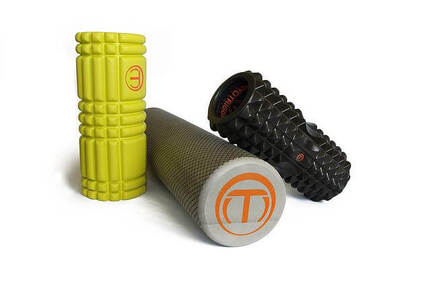Foam rollers- roll your way to better health!
You may have seen, used, or heard of foam rollers- they are a cheap and effective way to release myofascial tightness and are ideal for self-massage, recovery sessions and rehabilitation. We use, recommend and sell them here at The Physio Nook.
How to use them-
You use your body weight to apply pressure to sore and tight areas of your body for 30 to 60 seconds. These sore points will then desensitize over time. Following regular use of a foam roller, we find our clients are often moving and exercising much more fluently and efficiently.
Some common techniques to use with a foam roller-
ITB Rolls-
Lay on the roller so that it sits under the outside of the thigh, just below the hip. Support the weight of your body on your hands and opposite leg. Then roll the roller back and forth from just below the hip to just above the knee…
Quads Rolls-
Lay face down with your weight on your elbows and the roller under the front of your thighs. Then roll the roller from the level of your groin to just above the knee (do not roll over the knee itself)…
Calf Rolls-
Sit on the floor and support yourself with your hands. Place the back of one calf on the roller and roll it from the back of the knee to just above your ankle…
Chest Stretch-
Sit on one end of a long roller and then lay back over it. Your head should be resting at the end of the roller and your knees should be bent so your feet rest flat on the floor. Bring your elbows up level with your shoulders with your elbows bent to 90 degrees. Open your arms out to the side and try to relax as gravity stretches the muscles of your chest and shoulders…
Thoracic Mobility Stretch- (one of my favourites…)
Lay across the roller with the roller around shoulder blade level. Have your knees bent, your feet flat on the floor and lift your hips off the floor. Then roll the roller back and forth from just below the neck (not the neck itself) down to the bottom of the rib cage. This really helps with thoracic segmental mobility and postural correction…
I hope this summary will help you or someone you know. As always, we are here at The Physio Nook to help out with any musculoskeletal disorders you may have. Feel free to call us, email, or drop in for a great service.
Paul Woodward
Principal Physiotherapist
The Physio Nook.
You use your body weight to apply pressure to sore and tight areas of your body for 30 to 60 seconds. These sore points will then desensitize over time. Following regular use of a foam roller, we find our clients are often moving and exercising much more fluently and efficiently.
Some common techniques to use with a foam roller-
ITB Rolls-
Lay on the roller so that it sits under the outside of the thigh, just below the hip. Support the weight of your body on your hands and opposite leg. Then roll the roller back and forth from just below the hip to just above the knee…
Quads Rolls-
Lay face down with your weight on your elbows and the roller under the front of your thighs. Then roll the roller from the level of your groin to just above the knee (do not roll over the knee itself)…
Calf Rolls-
Sit on the floor and support yourself with your hands. Place the back of one calf on the roller and roll it from the back of the knee to just above your ankle…
Chest Stretch-
Sit on one end of a long roller and then lay back over it. Your head should be resting at the end of the roller and your knees should be bent so your feet rest flat on the floor. Bring your elbows up level with your shoulders with your elbows bent to 90 degrees. Open your arms out to the side and try to relax as gravity stretches the muscles of your chest and shoulders…
Thoracic Mobility Stretch- (one of my favourites…)
Lay across the roller with the roller around shoulder blade level. Have your knees bent, your feet flat on the floor and lift your hips off the floor. Then roll the roller back and forth from just below the neck (not the neck itself) down to the bottom of the rib cage. This really helps with thoracic segmental mobility and postural correction…
I hope this summary will help you or someone you know. As always, we are here at The Physio Nook to help out with any musculoskeletal disorders you may have. Feel free to call us, email, or drop in for a great service.
Paul Woodward
Principal Physiotherapist
The Physio Nook.


